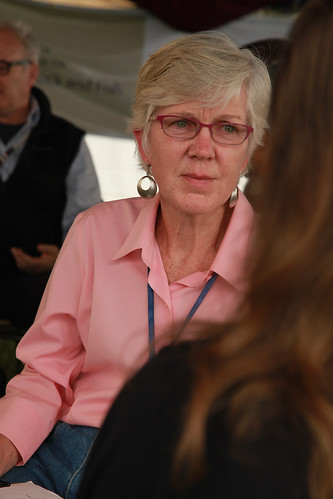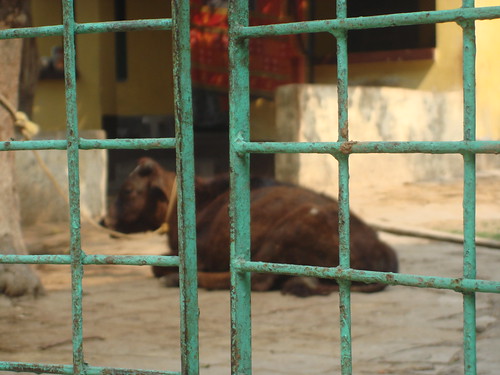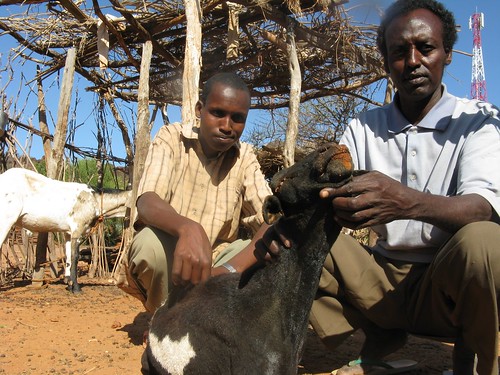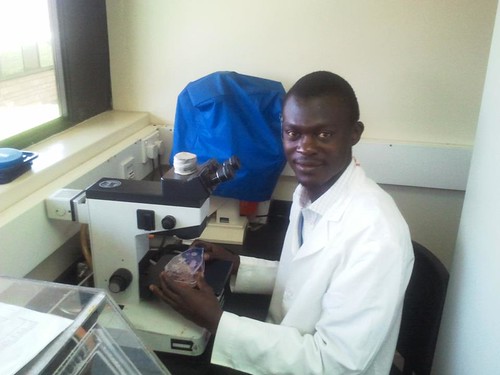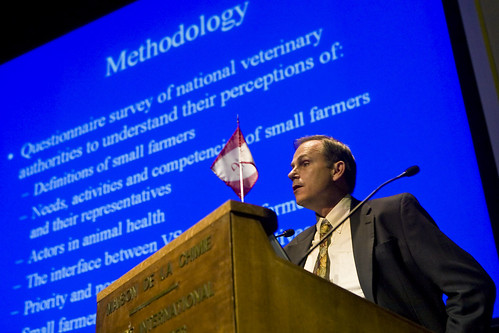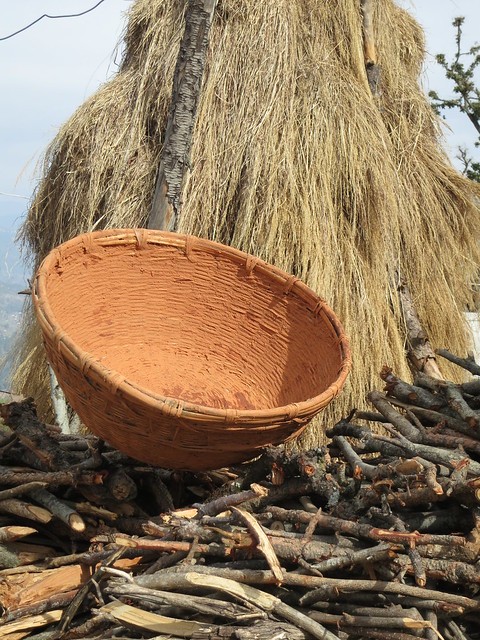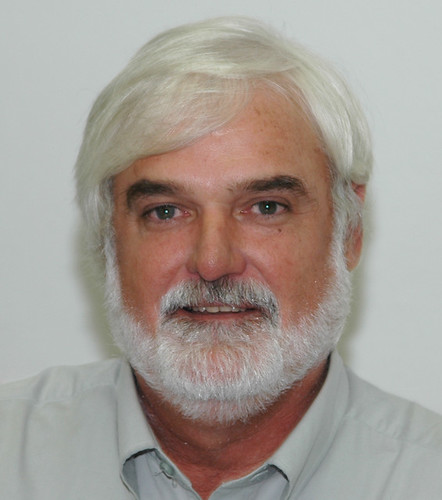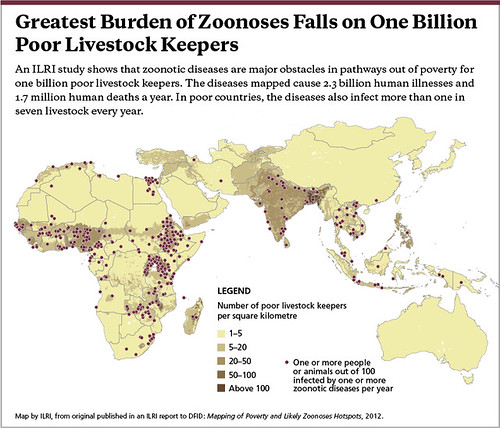
Map by ILRI, published in an ILRI report to DFID: Mapping of Poverty and Likely Zoonoses Hotspots, 2012.
A new study maps hotspots of human-animal infectious diseases and emerging disease outbreaks. The maps reveal animal-borne disease as a heavy burden for one billion of world’s poor and new evidence on zoonotic emerging disease hotspots in the United States and western Europe.
The new global study mapping human-animal diseases like tuberculosis (TB) and Rift Valley fever finds that an ‘unlucky’ 13 zoonoses are responsible for 2.4 billion cases of human illness and 2.2 million deaths per year. The vast majority occur in low- and middle-income countries.
The study, which was conducted by the International Livestock Research Institute (ILRI), the Institute of Zoology (UK) and the Hanoi School of Public Health in Vietnam, maps poverty, livestock-keeping and the diseases humans get from animals, and presents a ‘top 20’ list of geographical hotspots.
From cyst-causing tapeworms to avian flu, zoonoses present a major threat to human and animal health,’ said Delia Grace, a veterinary epidemiologist and food safety expert with ILRI in Kenya and lead author of the study. ‘Targeting the diseases in the hardest hit countries is crucial to protecting global health as well as to reducing severe levels of poverty and illness among the world’s one billion poor livestock keepers.’
‘Exploding global demand for livestock products is likely to fuel the spread of a wide range of human-animal infectious diseases,’ Grace added.
According to the study, Ethiopia, Nigeria, and Tanzania in Africa, as well as India in Asia, have the highest zoonotic disease burdens, with widespread illness and death. Meanwhile, the northeastern United States, Western Europe (especially the United Kingdom), Brazil and parts of Southeast Asia may be hotspots of ’emerging zoonoses’—those that are newly infecting humans, are newly virulent, or have newly become drug resistant.
The study examined the likely impacts of livestock intensification and climate change on the 13 zoonotic diseases currently causing the greatest harm to the world’s poor.
The report, Mapping of Poverty and Likely Zoonoses Hotspots, was developed with support from the United Kingdom’s Department for International Development (DFID). The goal of the research was to identify areas where better control of zoonotic diseases would most benefit poor people. It also updates a map of emerging disease events published in the science journal Nature in 2008 by Jones et al.[i]
Remarkably, some 60 per cent of all human diseases and 75 per cent of all emerging infectious diseases are zoonotic.
Among the high-priority zoonoses studied here are ‘endemic zoonoses’, such as brucellosis, which cause the vast majority of illness and death in poor countries; ‘epidemic zoonoses’, which typically occur as outbreaks, such as anthrax and Rift Valley fever; and the relatively rare ’emerging zoonoses’, such as bird flu, a few of which, like HIV/AIDS, spread to cause global cataclysms. While zoonoses can be transmitted to people by either wild or domesticated animals, most human infections are acquired from the world’s 24 billion livestock, including pigs, poultry, cattle, goats, sheep and camels.
Poverty, zoonoses and markets
Today, 2.5 billion people live on less than USD2 per day. Nearly three-quarters of the rural poor and some one-third of the urban poor depend on livestock for their food, income, traction, manure or other services. Livestock provide poor households with up to half their income and between 6 and 35 per cent of their protein consumption. The loss of a single milking animal can be devastating to such households. Worse, of course, is the loss of a family member to zoonotic disease.
Despite the danger of zoonoses, the growing global demand for meat and milk products is a big opportunity for poor livestock keepers.
Increased demand will continue over the coming decades, driven by rising populations and incomes, urbanization and changing diets in emerging economies,’ noted Steve Staal, deputy director general-research at ILRI. ‘Greater access to global and regional meat markets could move millions of poor livestock keepers out of poverty if they can effectively participate in meeting that rising demand.’
But zoonoses present a major obstacle to their efforts. The study estimates, for example, that about one in eight livestock in poor countries are affected by brucellosis; this reduces milk and meat production in cattle by around 8 per cent.
Thus, while the developing world’s booming livestock markets represent a pathway out of poverty for many, the presence of zoonotic diseases can perpetuate rather than reduce poverty and hunger in livestock-keeping communities. The study found a 99 per cent correlation between country levels of protein-energy malnutrition and the burden of zoonoses.
Many poor livestock keepers are not even meeting their own protein and energy needs’, said Staal. ‘Too often, animal diseases, including zoonotic diseases, confound their greatest efforts to escape poverty and hunger.’
Assessing the burden of zoonoses
The researchers initially reviewed 56 zoonoses that together are responsible for around 2.5 billion cases of human illness and 2.7 million human deaths per year. A more detailed study was made of the 13 zoonoses identified as most important, based on analysis of 1,000 surveys covering more than 10 million people, 6 million animals and 6,000 food or environment samples.
The analysis found high levels of infection with these zoonoses among livestock in poor countries. For example, 27 per cent of livestock in developing countries showed signs of current or past infection with bacterial food-borne disease—a source of food contamination and widespread illness. The researchers attribute at least one-third of global diarrheal disease to zoonotic causes, and find this disease to be the biggest zoonotic threat to public health.
In the booming livestock sector of developing countries, by far the fastest growing sectors are poultry and pigs.
As production, processing and retail food chains intensify, there are greater risks of food-borne illnesses, especially in poorly managed systems’, said John McDermott, director of the CGIAR Research Program on Agriculture for Nutrition and Health, led by the International Food Policy Research Institute (IFPRI). ‘Historically, high-density pig and poultry populations have been important in maintaining and mixing influenza populations. A major concern is that as new livestock systems intensify, particularly small- and medium-sized pig production, the more intensive systems will allow the maintenance and transmission of pathogens. A number of new zoonoses, such as Nipah virus infections, have emerged in that way.’
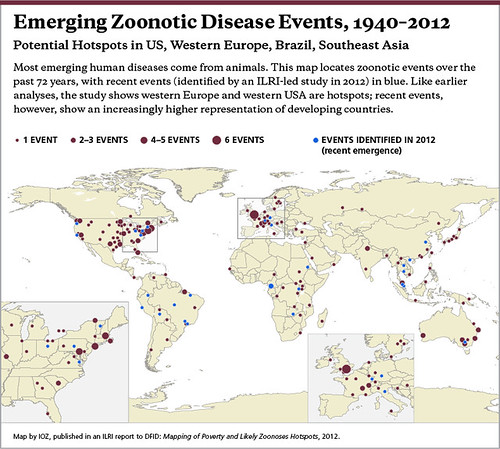
Map by Institute of Zoology (IOZ), published in an ILRI report to DFID: Mapping of Poverty and Likely Zoonoses Hotspots, 2012.
Intensification and disease spread
The most rapid changes in pig and poultry farming are expected in Burkina Faso and Ghana in Africa and India, Myanmar and Pakistan in Asia. Pig and poultry farming is also intensifying more rapidly than other farm commodity sectors, with more animals being raised in more concentrated spaces, which raises the risk of disease spread.
Assessing the likely impacts of livestock intensification on the high-priority zoonoses, the study found that livestock density is associated more with disease ‘event emergence’ than with overall disease burdens. Both the northeastern United States and Western Europe have high densities of livestock and high levels of disease emergence (e.g., BSE, or ‘mad cow’ disease, and Lyme disease), but low numbers of people falling sick and dying from zoonotic diseases. The latter is almost certainly due to the relatively good disease reporting and health care available in these rich countries.
Bovine tuberculosis is a good example of a zoonotic disease that is now rare in both livestock and human populations in rich countries but continues to plague poor countries, where it infects about 7 per cent of cattle, reducing their production by 6 per cent. Most infected cattle have the bovine form of TB, but both the human and bovine forms of TB can infect cows and people. Results of this study suggest that the burden of zoonotic forms of TB may be underestimated, with bovine TB causing up to 10 per cent of human TB cases. Human TB remains one of the most important and common human diseases in poor countries; in 2010, 12 million people suffered from active disease, with 80 per cent of all new cases occurring in 22 developing countries.
Massive underreporting
We found massive underreporting of zoonoses and animal diseases in general in poor countries’, said Grace. ‘In sub-Saharan Africa, for example, 99.9 per cent of livestock losses do not appear in official disease reports. Surveillance is not fulfilling its purpose.’
The surveillance lacking today will be even more needed in the future, as the climate changes, she added. Previous research by ILRI and others indicates that areas with increased rainfall and flooding will have increased risk of zoonoses, particularly those diseases transmitted by insects or associated with stagnant water or flooding.
The main finding of the study is that most of the burden of zoonoses and most of the opportunities for alleviating zoonoses lie in just a few countries, notably Ethiopia, Nigeria, and India. These three countries have the highest number of poor livestock keepers, the highest number of malnourished people, and are in the top five countries for both absolute numbers affected with zoonoses and relative intensity of zoonoses infection.
‘These findings allow us to focus on the hotspots of zoonoses and poverty, within which we should be able to make a difference’, said Grace.
Read the whole report: Mapping of poverty and likely zoonoses hotspots, report to the UK Department for International Development by Delia Grace et al., ILRI, Institute of Zoology, Hanoi School of Public Health, 2012.
Read about the report in an article in Nature: Cost of human-animal disease greatest for world’s poor, 5 Jul 2012. Nature doi:10.1038/nature.2012.10953
[i] Nature, Vol 451, 990–993, 21 February 2008, Global trends in emerging infectious diseases, Kate E Jones, Nikkita G Patel, Marc Levy, Adam Storeygard, Deborah Balk, John L Gittleman and Peter Daszak.


